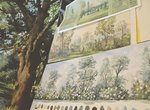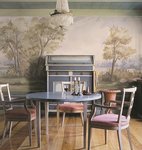Each time she has picked up and moved a long distance, Susan Harter has experienced a bit of a culture shock.
Her latest transition brought her and her husband, Matt, to Port Townsend from Boston, …
This item is available in full to subscribers.
We have recently launched a new and improved website. To continue reading, you will need to either log into your subscriber account, or purchase a new subscription.
If you had an active account on our previous website, then you have an account here. Simply reset your password to regain access to your account.
If you did not have an account on our previous website, but are a current print subscriber, click here to set up your website account.
Otherwise, click here to view your options for subscribing.
* Having trouble? Call our circulation department at 360-385-2900, or email our support.
Please log in to continue |
|




Each time she has picked up and moved a long distance, Susan Harter has experienced a bit of a culture shock.
Her latest transition brought her and her husband, Matt, to Port Townsend from Boston, where she started her high-end interior wall mural business several years ago. Hers is one of only eight companies like it in the world.
"What we are doing that's unique is using our trade-secret process to copy rooms at museum quality, printing them on the luxury level as rooms that are scaled and complete," said Harter. "It's very easy to take a single piece of artwork, put it on a scanner, blow it up and call it a mural. The difference is we're starting with a life-size mural, so when it's photographed, reproduced and printed, it looks as though I came in the house and painted it."
One year after moving here, she is still positive it was the right thing to do. "There are so many things I love about the Northwest." As she ticked off the reasons, she mentioned "tremendously welcoming," "amazingly kind" and "so supportive.
"There's an emphasis on quirkiness and individuality. I think it's easier to be creative here."
ARTS & NONPROFITS
Harter wasn't always an artist. She grew up in a working-class Detroit suburb, where she chose playing the trombone over taking art classes. Since a number of professional basketball players had come from her high school, and she had grown to be 6 feet 4 inches tall, she was an obvious recruitment target.
"I didn't really want to play, but a group of girls took me out on the schoolyard and said they would beat me up if I didn't. It turns out they were just bluffing; they were wonderful girls," Harter said.
Because she got good grades, and basketball scouts seemed to swarm all over her school looking for talent, a school guidance counselor encouraged her to "think big" when choosing a college. She decided to try for Harvard.
She got in. And she met people who thought having $1,000 a week for spending money wasn't enough.
She thought she'd become a marine biologist, but she'd been a vegetarian since she was 13 and dissecting animals didn't it into her ethics. When a friend dragged her to an art class, the teacher looked at her work and told her this was a life's calling.
"Promise me you'll never stop doing it," said the teacher.
It was a painting class that stopped her in her tracks, if only for a while. Art supplies for the class were projected to cost $1,200, and her teacher expected her to travel to New York City to buy them. She ended up out in the hall crying over it.
She studied film instead, because it was free, and graduated in 1990. After graduation, she worked in development at some Boston-area museums, including the Isabella Stewart Gardner Museum.
"I made a decision when I was about 18 that I would only work in the arts or for a nonprofit. I'd probably be a lot richer if I hadn't made that decision," Harter said.
TREES FROM MEMORY
After graduation, Harter lived in Cambridge with a group of girls in a house so small that when she decided to paint a dresser in Swedish antique style, she had to do it on the front lawn.
A woman walked by and said, "Hey, that's pretty good. Could you do that for me?"
"You'd have to pay me," Harter responded.
"Of course I'd pay you," said the woman. "I'm an interior designer."
Instantly, Harter was hired to paint a coffee table for a price greater than her weekly museum salary. She went back to work a couple of days later, gave her notice and started a decorative painting business.
"It was a good way to learn how to be a painter," Harter said.
From furniture she went to walls, after she started working with the late Sandra Kiss London, founder of the company Faux Like a Pro.
Once, when at a job site with Kiss London, the client asked for an Italian scene on the walls of her circular stairway. As they were leaving, Harter asked Kiss London who was going to paint the mural.
"You are," Kiss London informed her.
It was literally the first landscape she had ever painted in her life, but Harter wasn't that nervous. She figured if the client didn't like it, it was only paint. The client liked it, and Harter got to keep the $5,000 advance money.
In retrospect, she thinks her first murals were "kind of bad."
"I think people have this idea that if you're an artist, it just springs from your head like Athena from Zeus' forehead," Harter said. "I spent hundreds of hours of work just learning to manipulate glaze ... pushing paint around."
When she was first learning how to draw, she taught herself by going to the 174-acre historical Mount Auburn Cemetery. There, she sat among the gravestones of Buckminster Fuller, B.F. Skinner, Julia Ward Howe and other famous thinkers, and drew countless trees and bushes every day for two summers.
"On my way out, I would throw them in the garbage because I wanted to not feel precious about it. You've got to learn to not care about the end result, but to care about developing your skill. I did it to not be scared about making art."
Now she can paint trees from memory.
A TRADE SECRET
During this period, Harter enrolled in the School of the Museum of Fine Arts (now at Tufts University), where she met her husband, Matt, who ran the computer art department. Later, he worked as the director of print technology for Boston's PBS station. The little trunk that spins around on "Antiques Roadshow" is one of his creations.
It was Matt who had the idea for Harter to paint on canvas in her own studio rather than directly on the wall and then hang the result like wallpaper, an old French technique called "maroulage."
Ten years ago, Matt also thought he could photograph the murals and turn them into wallpaper. He came up with a trade-secret process to do just that even though "it's really not as easy as you'd think to take a picture of a piece of artwork that is 8 feet high and 60 feet long," Harter said.
To achieve their goal, the two of them "spent $2,500 on Craigslist stuff, made a few trips to Home Depot, and MacGyvered it all together." When a competitor saw the result, she remarked about the quality, which was better than the $150,000 room-size scanner that business had recently purchased. Because it is digital, Harter's process leaves room for custom tailoring. If a doorway or window would cut out a dominant tree, the mural can be adjusted for that.
Most of her competitors are based in Paris or London, and have the murals hand-painted in China or Korea. Some have been in business since the late 1700s. Harter's studio is in the Mount Baker Block Building in downtown Port Townsend.
Harter feels the business model of many of her competitors, based on cheap Chinese labor, could easily get shaken up. Since Chinese companies have a higher profit margin in the labor category than any other expenses, she has projected the margin will shrink if laborers begin to get paid more.
"I like to see people paid fairly," Harter said, noting that her grandfather was one of the "sit-down strikers" in Michigan in the 1930s. She has three part-time employees.
Currently, Susan Harter Muralpapers (susanharter.com) offers seven designs in three colorizations inspired by the English Cotswolds. Right now, she is busy working on a new collection using ink-and-wash Dutch landscapes, hoping to launch it in the next few months. Someday, she'd like to do an American series.
Customer service is also important to her. She thinks about what makes it easy for them at all times. A Harter mural – luxurious and expensive to most of us – is cheaper, faster and easier to install than other sources.
"I never want to let a designer down," she said.
DESIGN ROCK STARS
Her clients are what most people would consider wealthy, and her colleagues are the rock stars of their field.
"It's an interesting world," said Harter. "I think people underestimate [interior design] from the outside because they imagine that anybody can fluff a pillow."
Harter explained that a vast knowledge of architecture, drafting and engineering are what separates the celebrity designers from the average ones. One must be accredited to be an interior designer, and there is a continuing-education component to keep designers current with new laws and trends.
Getting your name known takes time, but after being in business for more than a decade, Harter has met some of the best American designers: Charlotte Moss, Jamie Drake, Juan Montoya and Bunny Williams.
Many of these designers participate in what are called "show houses." A show house is created when a charity gets a big, old mansion needing a redo and invites interior designers to pay for the privilege to come and design rooms. These are the kind of homes where a chandelier may be worth $250,000; a sconce, $60,000. Tickets are sold to "ladies who lunch," who tour the house and receive a catalog of their own for future projects at home.
In 2009, Harter exhibited her work in a decrepit $30 million New York City mansion, which also hosted an event to honor the late Albert Hadley, who had worked on the interior design of the Kennedy White House. Hadley's clients have included Brooke Astor, Oscar and Annette de la Renta, and Al and Tipper Gore.
At the show, when their paths crossed, the late Hadley shook Harter's hand and said her work was "very, very pretty." Harter was thrilled when Hadley's assistant took her aside and explained that Hadley had been at his most enthusiastic. "Two 'verys'? That's as much praise as you will ever get out of Albert Hadley!"
A Harter mural is also going into the Chancellor Mansion set of the soap opera "The Young and the Restless." Initially, the mansion was redone to give it a more modern look, but fan outcry pushed show executives to change the set yet again to a more formal mansion decor. In a survey taken on the Soap Shows website (soapshows.com), out of about 5,000 votes, 85 percent were appalled that the set designers would make such a drastic change. To appease fans, the set designers chose a Harter mural to include in the second effort.
FOUR BLIZZARDS
Port Townsend is a long way from Detroit and Boston, and nothing like either of those cities. While traveling for business to Seattle a year or so ago, Harter saw people wearing shorts and sailing on Lake Union while those back home were still wearing heavy coats, hats and gloves. Why live in a place where there were four blizzards in one winter, and her car was buried in snow for three months, when she and her husband could live here? Someone in Boston tipped her off to Port Townsend, and not long after, the couple traveled here, stayed at the Palace Hotel, woke up the next morning and bought a house.
Harter knows that the landscapes she has painted so far don't really it into the Northwest aesthetic. "The East Coast is about self-expression within defined parameters. There's a shared language of style."
Nevertheless, she's happily settled now and focused on increasing business. She's learning how to move through a more relaxed atmosphere in which people want to chat a little before getting down to business. It's different from anything she's ever experienced.
"I love the looseness of it. I want to spend the rest of my life here."
"The East Coast is about self-expression within defined parameters. There's a shared language of style."
Susan Harter
MURAL ARTIST
"There's an emphasis on quirkiness and individuality. I think it's easier to be creative here."
Susan Harter
MURAL ARTIST